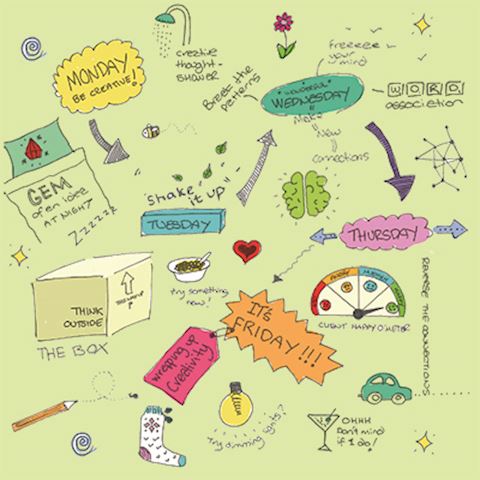
Navigating the rise of technology in construction
In this article we’ll dive into the booming world of smart construction technology, exploring the innovations driving the change and what the future looks like for the industry.

Do you feel that your most creative ideas seem to happen at random times? Or that you’re hit with a flash of inspiration when it’s inconvenient and you don’t have pen and paper to hand? When diarised, our creative flare can feel much harder to tap into. So however hard we try, can a scheduled brainstorm ever be an effective way to generate new ideas? We think it can. Here we give a few pointers to release your creative spirit, even on a timeline.
Monday – be creative
Mondays are likely to get a whole lot harder when you add a ‘be creative’ brainstorm session smack bang in the diary. There is every chance that Monday could prove to be the worst day for a alighting on a clever new solution to your marketing campaign, especially if you’re feeling refreshed following a relaxing weekend.
You may be surprised to learn that creativity thrives on tiredness. There are multiple studies and articles linking mental fatigue and creativity. Think about it, have you ever had a gem of an idea come to you in the middle of the night? (Again, without your pen or paper to hand!) This is because making different connections occurs more easily when we allow our minds to wander – which we do when tired. Thinking logically with lots of structure in our thoughts – as we often do on Mondays – we are less likely to allow random, radical thoughts into our headspace.
Tuesday – be disruptive
"Thinking outside the box" is easier when we actively behave differently. Try disrupting yourself and alter your everyday routine. Habits can stifle creativity and allow us to go through the day on autopilot. Try eating a new breakfast cereal, take a different route to work, and choose another seat in the meeting. What if you choose to face the wall rather than the group? How different would that feel – for everyone in the room?
To shake-up things up further, try giving individuals new roles and use proven techniques to interrogate a topic to get a new perspective. We use disruption techniques to help challenge what we know and believe. Getting out of our comfort zone has helped us to get to some of our award-winning ideas. Try it with your team and find out how doing things differently can boost your creativity.
Wednesday – making new connections
The pressure to come up with amazing and original ideas is naturally quite daunting. However, it doesn’t have to be: you know most of what you need to know already. It’s about making new connections – a viewpoint shared by Steve Jobs, “Creativity is just about connecting things”. So that’s good news. We have plenty of material to work with. Our brains are already crammed with experiences, knowledge and examples of things that have worked or not worked, and the reasons why.
Using creative thinking techniques enables you to break down some of the patterns which are holding you back. A familiar and effective technique to generate new ideas is word association. This is where you start with your key word at the centre and make links to connected words. With every new word you make further connections, which can lead to whole new lines of thinking as you move away from the central word. For example, if you put the word ‘Customer’ in the centre you could easily link to ‘Satisfaction’, and then one of the team adds ‘The Rolling Stones’ and another mentions the song ‘Paint it Black’. You can then try and connect these words with the central Customer challenge. This is just one way a new campaign can be born. Of course the connections you make will be different to ours, and as you free your mind and think about your challenges differently, you will begin to identify new links and potentially fresh ideas.
Thursday – reversing connections
There are a lot of thinking techniques which can be used to challenge and build opportunities. By mixing up the methods you choose, you may well find yourself making a shift in your viewpoint. Try unfamiliar techniques that will take you out of your comfort zone – beyond your comfort zone inspiration flourishes. So even if it feels awkward, suspend judgement and see what happens.
One of our favourite alternative thinking techniques is called ‘reverse brainstorming’. This disrupts how you approach your challenge right at the outset. Start by reversing the question you are trying to answer. For example, if you want ‘a happy customer’ you get everyone to find ways to create ‘an unhappy customer’. Once you think you have all the answers to their unhappiness covered, you address each point from the opposite viewpoint. By solving all the causes which make customers unhappy you stride towards the holy grail of the happy customer.
Friday – wrapping-up creativity
It’s nearly the weekend and you’re running out of time for creative inspiration. Have you considered changing how you feel? Can you make changes to your environment? Try dimming the lights and allow your other senses to come to the forefront. Short bursts of sensory deprivation can change your focus. The different perspective could be what’s required to make those essential new connections.
Deadlines and constraints, as well as environmental factors, are all part of the creative mix. Constraint, like tiredness, is another friend of creativity. Thank goodness for that Friday feeling! Even if the pace of work doesn’t slow down, we often feel and act differently on a Friday. We are potentially more creative – tired and running out of time. We start to dismiss the ordinary for the extraordinary and with the pressure to deliver we leapfrog the mundane and seek out the sizzle!
If you're looking for ways to better tap into your creativity, contact Rachel Arquati about creative thinking techniques and let Clear help you find your big idea.



In this article we’ll dive into the booming world of smart construction technology, exploring the innovations driving the change and what the future looks like for the industry.

Learn how to use presentation opportunities as an effective lead-generation tool in your trade show activity.

Great marketing success comes from keeping your communications focused, engaging and simple to ‘get’ - but that isn’t always so simple to achieve.

With multiple types of technologies being considered, we bring you a snapshot of alternative fuels and review the most prominent pros and cons for each one.